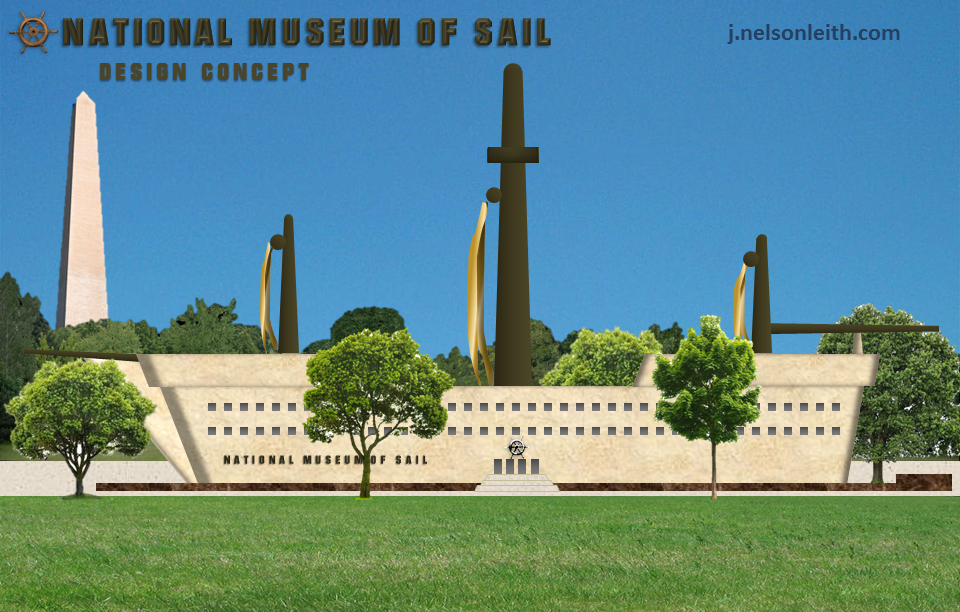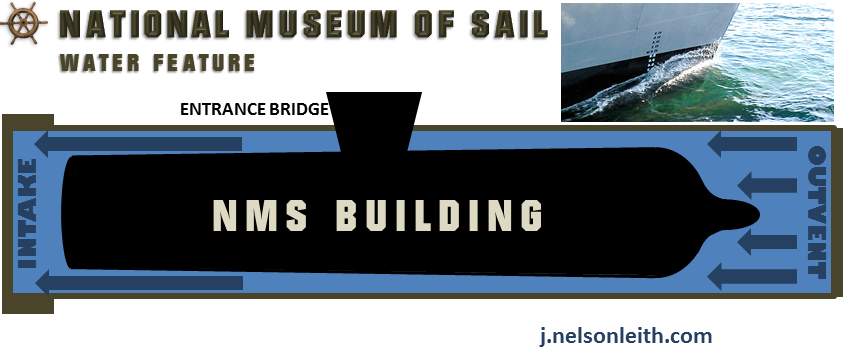![]() Ahoy! My latest design sketch, draft, or preliminary concept once again falls into the broad “civil planning” category.
Ahoy! My latest design sketch, draft, or preliminary concept once again falls into the broad “civil planning” category.
I propose a new Smithsonian museum dedicated to the history of sail. Although this might seem like a niche subject, not only does the history of sailing cover the majority of human history and the majority of the Earth’s surface, but the United States was conceived and born through the power of sail. Such a huge chunk of our vocabulary is derived from the culture of sail that there are entire dictionaries devoted to etymologically nautical words and phrases, like Peter D. Jeans’s Ship to Shore: A Dictionary of Everyday Words and Phrases Derived from the Sea.
In this proposal (really just a fun blog post) I’ll talk about why America’s early maritime history is important, and the interesting features such a museum could have, including graphic depictions.
_
WHY A MUSEUM OF SAIL?
Why? Because there was a great transformation in the culture, politics, and economy of the United States in the mid-1800s which goes largely unrecognized. We went from an outward-looking, maritime, pre-industrial, sail-driven country to an inward-looking, terrestrial, industrial, rail-driven country. Rather than wind-riders working with Nature, we began to see ourselves as Nature’s steam-powered conquerors. The Romance of the Sea was replaced with the Romance of the West, and the setting of our dreams became less watery than arid.
Because of this shift, the American sense of foreignness became less defined by what was across the Atlantic in Europe and more by what was across the deserts in Mexico. We became more consciously American at this time, but also more isolationist. This metamorphosis was sealed in our great Civil War, a conflict against ourselves, wherein more Americans died than both World Wars and Viet Nam combined.

The tragedy of the life and career of Herman Melville—the great prophet of American literature—is that he wrote maritime novels at the very moment the nation was turning away from the sea. Melville enjoyed a revival of popularity only after the Romance of the West had burned itself out, and America was forced out of its isolation by events across the sea in Europe.
In fact, I would claim three great periods of American history: the Age of Sail, the Age of Rail, and the Great American Century of the airplane and automobile. Each of these could have its own museum, but for today I am going to focus on the longest of these ages, which reaches backward from America’s adolescence to the beginning of recorded history.
_
WHAT WOULD NMS LOOK LIKE?
 The museum would be designed to mimic a sailing ship with simplified masts. The truncated masts would feature yards on which banners could be draped like sails. The mainmast could also contain an elevator to a “Crow’s Nest” providing a unique view of the city. This would be more or less scenic depending on the placement of the museum (See “Where would we put it?” below).
The museum would be designed to mimic a sailing ship with simplified masts. The truncated masts would feature yards on which banners could be draped like sails. The mainmast could also contain an elevator to a “Crow’s Nest” providing a unique view of the city. This would be more or less scenic depending on the placement of the museum (See “Where would we put it?” below).
The verisimilitude would be limited, of course. The decks of real tall-ships are curved, and this would be problematic in a standing structure. Also, rather than boarding through the upper deck, visitors would enter through a doorway—along the port side of the museum, of course.
A central elevator in the main lobby would travel up the mainmast to the Crow’s Nest, with ample space around for exhibits needing a lot of vertical room. Hallways would lead away from this main lobby fore and aft, to permanent exhibits on:
- The pre-American history of sea travel.
- The mechanics of sailing, navigation, and shipbuilding.
- The role of the infamous Triangle Trade in American history.
- American naval history before the advent of steam power.
- Piracy, maritime law, and maritime commerce.
- Life aboardship in the Age of Sail, including clothing, cuisine, health issues, work routines, and culture.
Atop the Museum could be a Captain’s Cabin restaurant with both weatherdeck and inside seating, a Foc’s’le Shop for souvenirs in the forecastle, and an outdoor display/event area on the waist around the mainmast.
The base of the museum would be surrounded by a water feature with an “endless pool” mechanism pumping water from the front of the pool toward the aft intake, breaking around the building itself to create the illusion of movement through water, and a bow wake at the front of the museum.

Staff would enter through an underground garage with an entrance located away from the building’s public perimeter.
_
WHERE WOULD WE PUT IT?
Four possible sites.

1. In East Potomac Park (generally southeast of the Jefferson Memorial), facing the river, is the ideal spot. This site is currently a small corner of the East Potomac Golf Course that dominates East Potomac Park, and is quite near the oft–proposed Jefferson Memorial Metro station. The selling points for this site include: proximity to the Jefferson Memorial and the potential Metro station; proximity to the main channel of the Potomac permitting a dock annex; and location downriver from the bridges associated with 14th Street, permitting visits by tall-ships that could not sail under those bridges.
An alternative East Potomac option (1a)would be to slide the museum grounds northeast so the docks would face The Wharf across the channel. This would be further from the proposed Jefferson Memorial station, but closer to Waterfront and L’Enfant stations if a water shuttle ferried tourists back-and-forth. Access to the historic DC Fish Market would be another plus for this alternative.
2. In West Potomac Park (west of the Jefferson Memorial and south of the Martin Luther King, Jr. Memorial), along the river, is a less ideal spot but still feasible. This would place NMS directly behind the FDR Memorial site, from the perspective of the Tidal Pool. Currently, public sports fields occupy this site. This location is also quite close to the prospective Jefferson Memorial Metro station. Proximity to the Tidal Pool and the Potomac itself is the selling point for this location: it is the most water-bound of all four.
3. Near the DC Waterfront, straddling two empty fields near the Southwest Duck Pond, is another potential site. This location is near two new DC government buildings, and within a block of Arena Stage and The Wharf waterfront renewal project. This would necessitate re-closing a stretch of 4th Street SW: it had been closed years ago when a mall was located here, and re-opened when the DC government buildings were finished.
Although this site is directly south on 4th from the National Museum of the American Indian and the National Air & Space Museum, it’s a good ten to fifteen minute walk through office- and residence-lined blocks. The proximity to the Wharf, where tall-ships could tie up, is really the only selling point for this site.
4. Near Buzzard Point—next to Fort McNair, the National Defense University, and the US Coast Guard Headquarters—is the least ideal of the four possibilities, despite being within walking distance of Nationals Park and the Titanic Memorial that marks the south end of The Wharf. This location is in a very cluttered, industrial neighborhood.
However, once developers complete the transformation of that weirdly desolate triangle of shoreline across from Nationals Park into a cluster of waterside residences and businesses (seriously, why has that wasteland just sat there for so long? zoning?) foot-traffic might be coaxed down a cleaned up Potomac Avenue toward this potential NMS site. Honestly, though, I would much prefer one of the other three sites.
_
WHAT SORT OF EVENTS WOULD HAPPEN AT NMS?
Archaeology tours. Of course, when traveling exhibits of shipwrecks and other maritime artifacts (ancient nautical artwork, port ruins, etc.) visit the Mid-Atlantic, NMS would be the natural choice.
Tall-ship visits. Passing under the 14th Street Bridge to the West Potomac Site might be impossible for tall-ships but, although the East Potomac site would require construction of a dock for visiting tall-ships, its immediate proximity to the water makes it the best site for visits from large sailing craft from around the world. There are small marinas near the Buzzard Point location, but none that would berth a large tall-ship. The Wharf would provide the best existing dock-space for such a visit, but it is not directly connected to the 4th Street site.
Pirate festival. Need more be said? Fun for all the family, and a draw for off-season Renn Faire enthusiasts. The Museum could feature pirate exhibits, pirate movies, and classes teaching pirate-y crafts and skills. A good time for such a festival would be mid-September.
Book signings/releases. The museum could work with academic and fiction publishers to showcase nautically themed novels and works of non-fiction.
Film festival. A week of the best movies set on the sea? Yes, please! An IMAX theater might snuggle nicely into the aft of the building.
Naval and Coast Guard ceremonies. The waist of the museum would provide a fantastic space for promotion, retirement, and other ceremonies for US Navy and US Coast Guard personnel. Off-hour events at the Captain’s Cabin could be arranged, as well.

derekalanwilkinson
September 6, 2013 at 6:47 pm
You didn’t come up with this just because you were in the NAVY, did you? lol. I agree, while I am a little jaded at the idea of D.C. having yet ANOTHER memorial/museum/whatever. Also, the concept of pirates would sell the idea.
Pasha
September 6, 2013 at 9:51 pm
I volunteer for the party crew!! (Do museums have party crews? If not, don’t you think they should?)